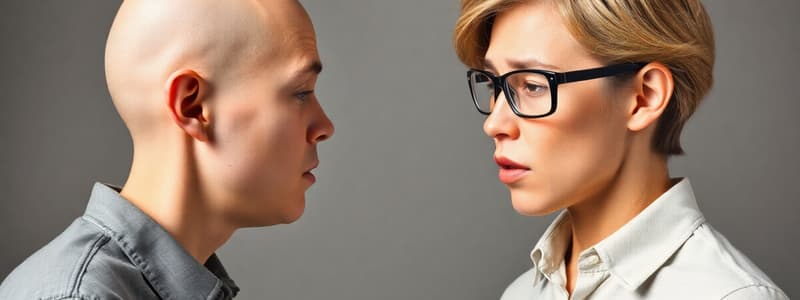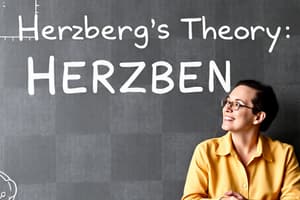Podcast
Questions and Answers
According to the James-Lange theory of emotion, which of the following scenarios best illustrates the sequence of events in emotional experience?
According to the James-Lange theory of emotion, which of the following scenarios best illustrates the sequence of events in emotional experience?
- Simultaneously feeling fear and experiencing a racing heart when confronted by a dangerous situation.
- Experiencing fear upon seeing a snake, which leads to the physiological changes such as increased heart rate and trembling.
- Noticing an increased heart rate and sweating, which leads to the interpretation of these physical responses as fear. (correct)
- Cognitively labeling the experience as fear, which causes an increase in heart rate and sweating in response to a threat.
In what crucial way does the Cannon-Bard theory of emotion differ from the James-Lange theory?
In what crucial way does the Cannon-Bard theory of emotion differ from the James-Lange theory?
- The Cannon-Bard theory asserts that emotions and physiological responses occur simultaneously, whereas the James-Lange theory suggests physiological responses precede emotion. (correct)
- The Cannon-Bard theory focuses on the role of the autonomic nervous system, while the James-Lange theory highlights the cerebral cortex.
- The Cannon-Bard theory posits that cognitive appraisal is necessary for experiencing emotion, while the James-Lange theory emphasizes physiological responses.
- The Cannon-Bard theory emphasizes the importance of interpretation in emotional experience, a step the James-Lange theory disregards.
According to the two-factor theory of emotion, what is the MOST critical factor in determining the specific emotion we experience?
According to the two-factor theory of emotion, what is the MOST critical factor in determining the specific emotion we experience?
- The cognitive interpretation and labeling of the arousal based on environmental cues. (correct)
- The individual's past experiences with similar situations.
- The intensity of the physiological arousal experienced.
- The specific pattern of physiological responses that occurs.
Imagine a person is injected with epinephrine. They are then placed in a room with someone behaving in a euphoric manner. According to the Schachter-Singer two-factor theory of emotion, what is the MOST likely outcome?
Imagine a person is injected with epinephrine. They are then placed in a room with someone behaving in a euphoric manner. According to the Schachter-Singer two-factor theory of emotion, what is the MOST likely outcome?
How would the James-Lange theory explain the experience of feeling joy at receiving a good grade?
How would the James-Lange theory explain the experience of feeling joy at receiving a good grade?
Which scenario aligns with the Cannon-Bard theory's explanation of how emotions are experienced?
Which scenario aligns with the Cannon-Bard theory's explanation of how emotions are experienced?
What pivotal role does cognitive appraisal play within the Schachter-Singer theory of emotion?
What pivotal role does cognitive appraisal play within the Schachter-Singer theory of emotion?
In the context of Maslow's hierarchy of needs, what differentiates self-actualization from all other levels?
In the context of Maslow's hierarchy of needs, what differentiates self-actualization from all other levels?
What is a key distinction between the concept of motivation and the concept of emotion?
What is a key distinction between the concept of motivation and the concept of emotion?
According to Maslow's hierarchy, why might an individual struggling with finding food and shelter find it difficult to focus on achieving their creative potential?
According to Maslow's hierarchy, why might an individual struggling with finding food and shelter find it difficult to focus on achieving their creative potential?
What implications can be drawn from the 'Angry/Happy Man Study' regarding the human emotional experience?
What implications can be drawn from the 'Angry/Happy Man Study' regarding the human emotional experience?
What is the MOST accurate interpretation of the 'interpretation' step in the two-factor theory of emotion?
What is the MOST accurate interpretation of the 'interpretation' step in the two-factor theory of emotion?
How does the concept of 'bodily arousal' relate to the broader understanding of emotion?
How does the concept of 'bodily arousal' relate to the broader understanding of emotion?
Which of the following aligns MOST closely with the self-actualization level of Maslow's hierarchy of needs?
Which of the following aligns MOST closely with the self-actualization level of Maslow's hierarchy of needs?
Why do the James-Lange and Cannon-Bard theories of emotions spark ongoing debate?
Why do the James-Lange and Cannon-Bard theories of emotions spark ongoing debate?
In Maslow's hierarchy of needs, could a person regress to a lower level even after reaching a higher one? If so, under what conditions?
In Maslow's hierarchy of needs, could a person regress to a lower level even after reaching a higher one? If so, under what conditions?
According to the two-factor theory of emotion, if a person experiences physiological arousal with no immediate explanation, then encounters a fearful event, what is the MOST probable outcome?
According to the two-factor theory of emotion, if a person experiences physiological arousal with no immediate explanation, then encounters a fearful event, what is the MOST probable outcome?
How does the 'Angry/Happy Man Study' challenge the notion that specific emotions are directly linked to specific physiological responses?
How does the 'Angry/Happy Man Study' challenge the notion that specific emotions are directly linked to specific physiological responses?
What is the primary difference between how the James-Lange theory and the two-factor theory account for the role of physiological arousal in emotional experience?
What is the primary difference between how the James-Lange theory and the two-factor theory account for the role of physiological arousal in emotional experience?
How does motivation relate to the process of fulfilling the different levels within Maslow's hierarchy of needs?
How does motivation relate to the process of fulfilling the different levels within Maslow's hierarchy of needs?
How does the Cannon-Bard theory address criticisms of the James-Lange theory regarding the specificity of physiological responses?
How does the Cannon-Bard theory address criticisms of the James-Lange theory regarding the specificity of physiological responses?
If someone is unable to accurately assess their physiological arousal during an emotional experience, which of the following outcomes aligns best with the two-factor theory of emotion?
If someone is unable to accurately assess their physiological arousal during an emotional experience, which of the following outcomes aligns best with the two-factor theory of emotion?
Given the principles of Maslow's hierarchy, what scenario would MOST likely enable an individual to reach self-actualization?
Given the principles of Maslow's hierarchy, what scenario would MOST likely enable an individual to reach self-actualization?
In the 'Angry/Happy Man Study,' how did the researchers manipulate the participants' cognitive interpretation of their arousal?
In the 'Angry/Happy Man Study,' how did the researchers manipulate the participants' cognitive interpretation of their arousal?
How does the concept of 'conscious experience' integrate with the understanding of emotions?
How does the concept of 'conscious experience' integrate with the understanding of emotions?
Why might an artist who lacks basic safety and security experience difficulty in achieving self-actualization through their art, according to Maslow's hierarchy of needs?
Why might an artist who lacks basic safety and security experience difficulty in achieving self-actualization through their art, according to Maslow's hierarchy of needs?
How does the Schachter-Singer theory differ from the James-Lange theory in explaining how we experience different emotions?
How does the Schachter-Singer theory differ from the James-Lange theory in explaining how we experience different emotions?
Given the findings of the 'Angry/Happy Man Study', what strategic implication can be derived for managing emotional responses in therapeutic settings?
Given the findings of the 'Angry/Happy Man Study', what strategic implication can be derived for managing emotional responses in therapeutic settings?
How does the order of components in experiencing emotions differ between the James-Lange theory and the two-factor theory?
How does the order of components in experiencing emotions differ between the James-Lange theory and the two-factor theory?
According to Maslow's hierarchy of needs, what might be the MOST likely outcome of an individual's prolonged failure to meet their belongingness and love needs?
According to Maslow's hierarchy of needs, what might be the MOST likely outcome of an individual's prolonged failure to meet their belongingness and love needs?
In the context of the 'Angry/Happy Man Study,' what critical finding challenged the conventional understanding of emotional determination?
In the context of the 'Angry/Happy Man Study,' what critical finding challenged the conventional understanding of emotional determination?
If an individual's physiological arousal during an emotional experience is markedly reduced to near baseline levels due to medical intervention, how might this impact their emotional experience according to the James-Lange theory?
If an individual's physiological arousal during an emotional experience is markedly reduced to near baseline levels due to medical intervention, how might this impact their emotional experience according to the James-Lange theory?
How can understanding Maslow's hierarchy of needs inform approaches to improve employee satisfaction and productivity in the workplace?
How can understanding Maslow's hierarchy of needs inform approaches to improve employee satisfaction and productivity in the workplace?
In what way did the experimental design of the 'Angry/Happy Man Study' control for the potential influence of pre-existing emotional states on the study outcomes?
In what way did the experimental design of the 'Angry/Happy Man Study' control for the potential influence of pre-existing emotional states on the study outcomes?
How does the two-factor theory's emphasis on cognitive appraisal expand our understanding of emotional responses in individuals with anxiety disorders?
How does the two-factor theory's emphasis on cognitive appraisal expand our understanding of emotional responses in individuals with anxiety disorders?
In a scenario where an individual encounters a bear, what statement reflects the James-Lange theory?
In a scenario where an individual encounters a bear, what statement reflects the James-Lange theory?
What central idea encapsulates the Cannon-Bard theory of emotion?
What central idea encapsulates the Cannon-Bard theory of emotion?
Using Maslow's hierarchy of needs, under which condition is an individual MOST likely to pursue self-actualization?
Using Maslow's hierarchy of needs, under which condition is an individual MOST likely to pursue self-actualization?
How would an individual who has satisfied the first four levels of Maslow's hierarchy of needs be expected to behave?
How would an individual who has satisfied the first four levels of Maslow's hierarchy of needs be expected to behave?
Participants in the 'Angry/Happy Man Study' who were injected with epinephrine and informed about the drug's effects MOST likely experienced what?
Participants in the 'Angry/Happy Man Study' who were injected with epinephrine and informed about the drug's effects MOST likely experienced what?
Flashcards
What is motivation?
What is motivation?
Factors that direct and energize behavior.
What is Maslow's hierarchy of needs?
What is Maslow's hierarchy of needs?
A list of ascending needs, from basic to complex, where basic needs must be met before higher-level needs can be achieved.
What is self-actualization?
What is self-actualization?
The need to find self-fulfillment and realize one's potential.
What is emotion?
What is emotion?
Signup and view all the flashcards
James-Lange theory of emotion
James-Lange theory of emotion
Signup and view all the flashcards
Cannon-Bard theory of emotion
Cannon-Bard theory of emotion
Signup and view all the flashcards
Two-factor theory of emotion
Two-factor theory of emotion
Signup and view all the flashcards
Study Notes
Emotion
- Emotion consists of bodily arousal and conscious experience
- Inquires as to which happens first when it comes to these components of emotion
- No definitive right answer regarding which comes first
Theories of Emotion
James-Lange Theory of Emotion
- Physiological arousal or behavior is experienced first in response to stimuli
- The emotional experience occurs due to the physiological response or behavior
- Physiological arousal or behavior then the emotion
Cannon-Bard Theory of Emotion
- Emotion and physiological reactions occur simultaneously
- Physiological arousal and emotion are experienced at the same time but operate simultaneously
Two-Factor Theory of Emotion (Schachter & Singer, 1962)
- Understanding emotions involves two steps
- First experience physiological arousal
- Next, interpret the reason for the physiological arousal by providing an explanation or label for it
- As a result of the interpretation, emotion is experienced
- Physiological arousal leads to interpretation leads to emotion
Angry/Happy Man Study (Schachter & Singer, 1962)
- Participants were injected with epinephrine or a placebo
- Participants were informed or not informed that the injection would cause arousal
- A confederate behaved in either an angry or happy manner
- Participants labeled the emotion
Motivation
- Motivation encompasses the factors that direct and energize behavior
- Motivation is within personality or a social area
- Motivation is what pushes someone to do something, and what persons are willing to put their time and energy into
- Types of motivation vary
Self-Actualization - Abraham Maslow
- Hierarchy of needs is a list of ascending needs from basic to more complex
- Basic needs must be achieved before higher-level needs can be achieved
- Physiological needs such as food, water, warmth, and rest are the most basic
- Safety needs such as security and safety
- Belongingness and love needs such as intimate relationships and friends
- Esteem needs cover prestige and feelings of accomplishment
- Self-actualization is about achieving one's full potential, including creative activities
- Need to find self-fulfillment and realize one's potential
- Most people are not self-actualized
- Around 42% of people are self-actualized
Studying That Suits You
Use AI to generate personalized quizzes and flashcards to suit your learning preferences.




